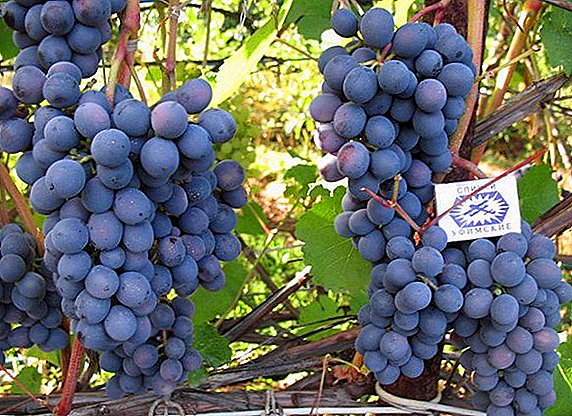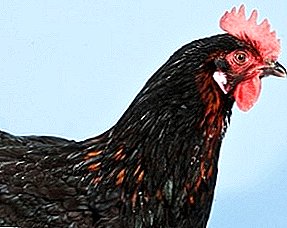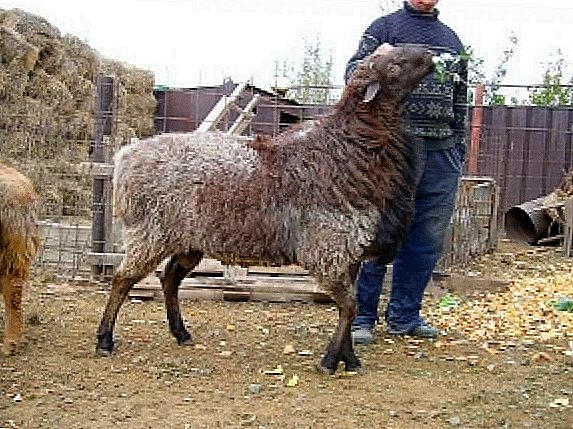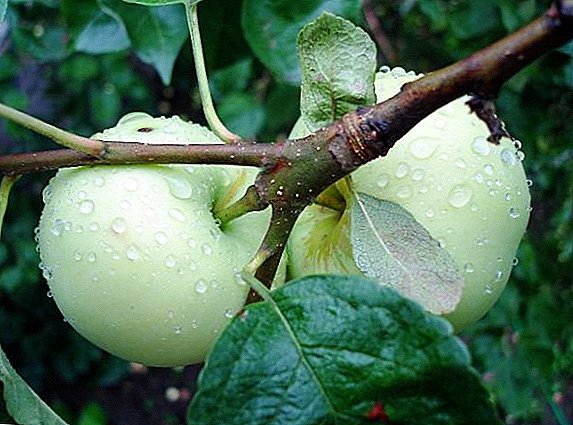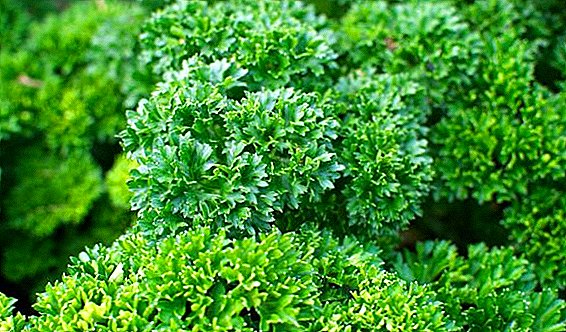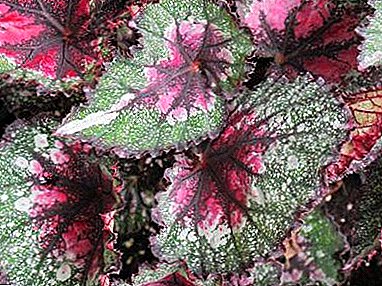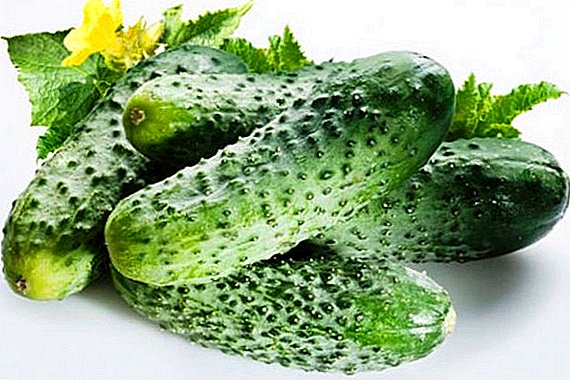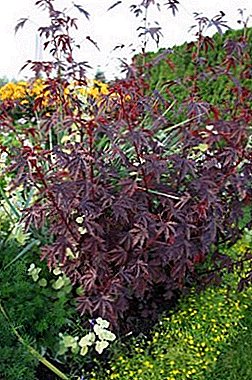
Red-leaved hibiscus is called sour because its flowers and leaves, which are edible, have a pleasant sour taste.
Characteristic, description of red-leaved hibiscus (sour)
- root system
For the red or sour hibiscus is characterized by the presence of a root system of mixed type. This means that when growing from seed, the main root initially develops, the growth of which usually stops by the fall of the first growing season. At this time, the development of adventitious roots begins.
 - leaves
- leaves
This plant has simple oval-shaped leaves that have from three to five blades. The diameter of the leaves is usually about ten centimeters, and the length reaches thirty. The leaves of hibiscus sour or krasnolistnogo can be painted in red-green, red, burgundy or bronze color. The leaves are located on the petioles, equipped with five radial veins, whose length can be from three to eleven centimeters.
- flowers
The diameter of the flowers of hibiscus sour or krasnolistnogo usually ranges from five to ten centimeters. Flowers are located one by one in the axils of the leaves, crowning the tops of the stems. Peduncle length is one centimeter. Flower color can be both pink and wine-red, as well as have different intermediate shades. The flower has many stamens, whose length reaches two centimeters.
- trunk
The trunk of a red hibiscus or sour has a woody base, from which vertical stems depart, which can be completely bare or have a slight pubescence. In height, this plant can grow up to one hundred centimeters under favorable conditions.
Caring for red hibiscus
 - landing
- landing
Planting hibiscus krasnolistnogo can be carried out in a flower pot, and in the open ground. If you want to grow hibiscus at your summer cottage, choose a well-lit and protected from the wind place. The diameter of the pit for planting hibiscus should be twice the size of the root system of the seedling. At the bottom of the pit is usually poured drainage, which is a layer of broken bricks, whose thickness should be about fifteen centimeters.
- transplanting
The young red hibiscus needs annual spring transplantation into a nutrient mixture of the earth of dense consistency. Grown up plants can be transplanted as needed.
If the plant has grown to such size that it is not easy to transplant it, you can replace only the top layer of the soil with a nutrient mixture.
- ground
As an ideal soil for red hibiscus, suitable soil substrate suitable for ornamental shrubs. You can also make your own soil mix. For this, it is necessary to mix humus, sod and leaf, as well as pine soil, in equal parts. Do not forget to add peat and sand to the soil.
To hibiscus easier to absorb nutrients from the soil, its acidity must be in the neutral range (pH 6-7).
- watering
In summer, the red-hibiscus needs plenty of watering every three to four days. It should always be in wet soil. In winter, watering should be moderate. The leaves of the plant should be regularly cleaned with a damp sponge to remove dust and dirt.
- air humidity
Hibiscus needs regular spraying. Excessive dryness of the air can cause the buds to fall off before they fully open.
When spraying it is necessary to ensure that water does not fall on the flowers, as this may cause dark spots to appear on them.
 - top dressing / fertilizer
- top dressing / fertilizer
Starting from the end of spring and ending in mid-September, sour or red-leaved hibiscus should be fed with a solution of mineral or organic fertilizers. Towards the middle of August, reduce the nitrogen content in the feed.
- light mode
Hibiscus loves the sun's rays, but in the summer it should be protected from the direct rays of the midday sun. In the apartment, this plant can also feel good on the north windows, if you take care of it properly.
- thermal mode
In the summer, hibiscus should grow at a temperature of twenty to twenty-two degrees above zero, and in winter it is recommended to keep it at a temperature of fourteen to sixteen degrees. Such a temperature differential has a beneficial effect on the flowering of the plant.
- life expectancy
With proper care, the life expectancy of hibiscus can be up to twenty years. In the open ground is usually grown hibiscus red-leaved or sour, which belong to the annuals.
 - bloom
- bloom
The appearance of flowers on hibiscus sour or krasnolistnom can be expected in September or in October. The life of one flower is only one day, but due to the fact that the plant has a large number of ovaries, its flowering lasts about a month.
- trimming
In spring, hibiscus, sour or red-leaved, needs rejuvenating pruning, which helps to form a beautiful plant shape, as well as stimulate flowering. Usually, one-third of the length of last year's gain is trimmed.
- reproduction (growing from seed)
Hibiscus sour or krasnolistny can be very easily grown from seeds. The beginning of this process should fall on the period from January to March. Before planting the seeds should be soaked in a solution of potassium permanganate dark pink and leave them there for half an hour. After that, the seeds must be placed for a day in a solution of epine, which should slightly cover them. For planting seeds, you will need containers filled with a mixture of peat and sand. They must be covered with glass and placed in a warm place.
When the seeds germinate, and seedlings will delight you with the first leaves, you can plant them in separate pots. In mid-May, sour or red-leaved hibiscus seedlings will be ready for planting in open ground.
Methods to combat diseases and pests
Red rose hibiscus Chinese rose boasts good resistance to pests and diseases. However, with a lack of moisture in the soil, the plant may be subject to attack by aphids, spider mites, thrips or whiteflies. To get rid of these pests, it is recommended to take a double treatment of hibiscus with insecticides such as Karbofos, Inta-vir, Aktellik or Fitoverm. The interval between treatments should be from seven to ten days.
 If your hibiscus has dropped the lower leaves, and the color of the new leaves is yellowish, this indicates that the plant is sick with chlorosis. This disease occurs due to the lack of iron and nitrogen in the soil. This problem can be corrected by adding iron chelate to the water for irrigation and adding a complex fertilizer, which includes nitrogen, to the soil each spring.
If your hibiscus has dropped the lower leaves, and the color of the new leaves is yellowish, this indicates that the plant is sick with chlorosis. This disease occurs due to the lack of iron and nitrogen in the soil. This problem can be corrected by adding iron chelate to the water for irrigation and adding a complex fertilizer, which includes nitrogen, to the soil each spring.
High soil moisture, overcooling hibiscus or finding it in an insufficiently lit place can lead to the fact that it begins to suffer from soot fungus or root rot. Cutting off the affected leaves and treating the plant with a fungicide will help get rid of this scourge.
Even a novice gardener will be able to grow sour or red-leaved hibiscus, as this plant is unpretentious and does not require complicated care.
A photo
More photos of red hibiscus, see below:







